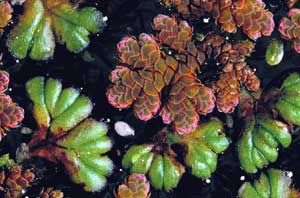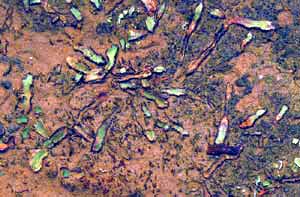In the Wild...
Where Do We Live?
A common misconception is that wet tropical rainforests and damp green gullies are the natural homes of lichens and bryophytes. The truth is that they are found in all terrestrial habitats, from rainforests to deserts, from sea level to alpine areas, and there are even a few aquatic species.
Lichens and bryophytes can be found on rocks, soil and tree trunks. While some will grow on a range of surfaces in a variety of habitats, others have very specific requirements. You will also find good lichen or bryophyte growth on the leaves of many plants especially in tropical forests. Mostly the crustose lichens or leafy liverworts are involved.
Lichens are generally light-loving, long-lived communities that tend to dominate areas where there is no competition from plants. Many bryophytes also don’t like intense plant competition, but some mosses can tolerate considerable competition and exist quite happily in lush, well-watered lawns.
 This group of boulders in Kosciuszko National Park has a good covering of many different lichens, mostly in the genus Xanthoparmelia. |
The open, trailing lichens and bryophytes are restricted to wetter areas, though moisture may come as regular fogs or dews, not necessarily through high rainfall. Their open, almost net-like growth forms mean they can quickly absorb atmospheric moisture from rain or fog, but they will dry out just as quickly. So they are not adapted for desert life.
The crustose lichens are drought resistant and well adapted to arid climates. They dominate the lichen species in deserts, alpine areas and the ice-free parts of the Arctic and Antarctic. Although you may not think of the polar areas as deserts, free water is very rare in the polar areas so they are also arid.
Some arid area mosses grow as small compact colonies of many plants. This densely clustered growth habit means the exposed surface area is made as small as possible and so water loss is greatly reduced. In other species white leaves or white hairs help to reflect excess heat. Such hairs also help to trap moisture from the air, especially from the cooler, moister air of early morning.
Many of the arid area liverworts are thallose, with the lobes curling up when dry and uncurling again when moist.
![An Australian Government Initiative [logo]](/images/austgovt_brown_90px.gif)













